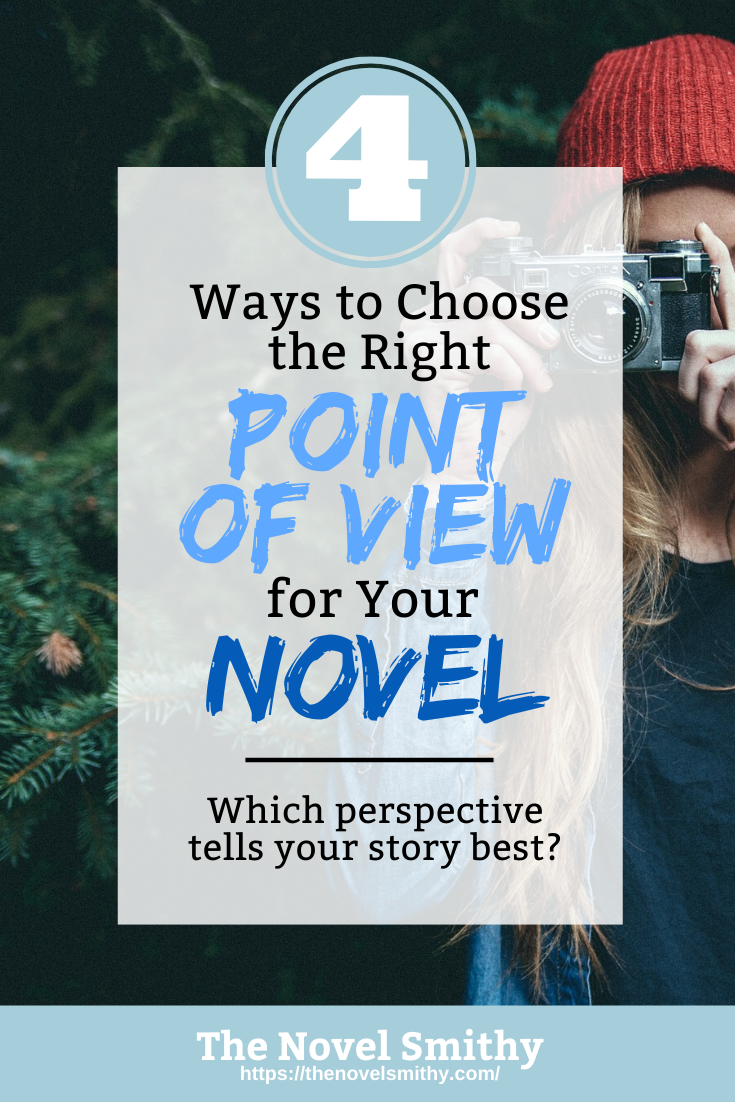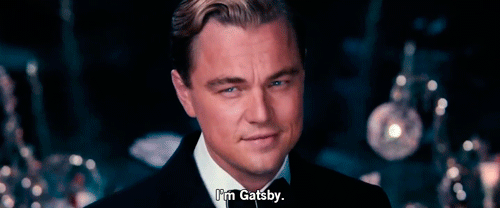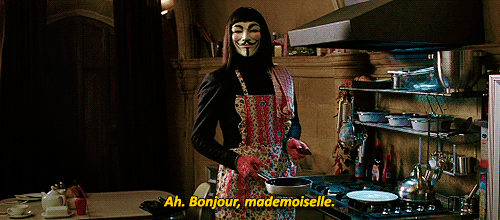4 Ways to Choose the Right POV for Your Novel
All writers have to deal with point of view eventually…
Whether you’re creating an intense epic fantasy or a short, cozy adventure, point of view is something that’ll deeply impact how you write your novel. Not only will it determine what information you can share with your reader, but it will also fundamentally change how your reader experiences your story.
Unfortunately, many writers aren’t clear on what point of view is to begin with. Sure, they hear about how important it is to understand, but they aren’t sure what their options are. So, today I’m going to walk you through the four types of point of view, along with how to choose the right point of view for your novel!
What is Point of View, and Why Does it Matter?
Contents
 In the world of fiction, point of view is defined as:
In the world of fiction, point of view is defined as:
“The narrative perspective from which your story is told.”
Occasionally point of view is referred to as narrative mode, but most often it’s just abbreviated as POV. Of course, “narrative perspective” isn’t the most intuitive term for many people, writers included.
If the definition above seems confusing, Kristen Kieffer from over at Well-Storied summed it up well when she described point of view as, “who is narrating your story.” This is what point of view is really all about, and it helps illustrate just how much point of view impacts your novel.
Who is telling your story, and what do they know that other characters don’t?
You see, when we talk about point of view, we often think it only impacts things like grammar and proofreading, since your novel’s point of view will determine which pronouns are appropriate for your story. For example:
First Person POV: “I rode out into the open field, filling my lungs with the fresh spring air.”
Third Person POV: “She rode out into the open field, filling her lungs with the fresh spring air.”
However, your story’s point of view will do far more than just change the pronouns you write with. It’ll be the lens through which your story is told, and will shape how your reader experiences your novel.
For instance, Third Person POV is more distant because it’s telling the story from an outside perspective. On the other hand, First Person POV is more immediate and intimate, though that also means it’s very limited. The reader can only experience the world from the perspective of the narrator, meaning they can’t see things the narrator doesn’t see or hear things they don’t hear. Third Person POV is far more flexible, letting you describe events, settings, and experiences with a wider lens.
The Four Types of Point of View
While I’ve already mentioned First and Third Person POV, there are actually four types of point of view common in fiction:
First Person POV – I/me/my/we
Peripheral First Person POV – I/me/my/we
Limited Third Person POV – he/she/they/it
Omniscient Third Person POV – he/she/they/it
Alongside these main four, there’s also a point of view called Second Person POV, where the author talks directly to the reader using you/your pronouns. However, this is very uncommon in fiction writing, and is definitely considered an advanced—and risky—writing style. Most novels use one of the four points of view listed above, meaning they’re the best place to start when trying to choose the right point of view for your story.
Of course, there’s another important term you should know: point of view character.
This is the character whose point of view the story is told from, be they your main character or an outside narrator. Technically, the author can be the narrator too!

It’s also important to note that your point of view character and your protagonist aren’t always the same thing, even in First Person POV. Your point of view character could be a secondary character who simply witnesses the events surrounding your protagonist, and this is where First Person Peripheral POV comes in (if you’re interested in the differences between your main character and your protagonist, check out this article).
So, before we move on to choosing the right point of view for your novel, let’s look at the four types of point of view you could choose.
First Person POV:
In First Person POV, the story is told from the perspective of the protagonist using I/me/my/we. This means the reader is limited to experiencing the story through their eyes only. They can’t peek into other character’s thoughts, and instead have to guess what other characters are feeling based on body language and dialog, just like we do in real life.
However, there is some extra nuance with both forms of First Person POV that comes in the form of reliable versus unreliable narrators. In First Person POV the reader experiences everything directly through the point of view character’s perspective, and this character can be untrustworthy, misinterpret things, or get led astray.
Because the reader is tied to them, this means the reader has to trust that character’s interpretation of events, making it possible to set up interesting twists and surprises later on.
Early one morning as we were beginning our day’s play in the back yard, Jem and I heard something next door in Miss Rachel Haverford’s collard patch.
We went to the wire fence to see if there was a puppy—Miss Rachel’s rat terrier was expecting—but instead we found someone sitting looking at us. Sitting down, he wasn’t much higher than the collards. We stared at him until he spoke. – Harper Lee’s To Kill a Mockingbird
Peripheral First Person POV:
This point of view uses the same pronouns as regular First Person POV—I/me/my/we—but in Peripheral First Person POV the point of view character is not the protagonist. Instead, they’re a secondary character who is witnessing the events surrounding the protagonist.
This means the reader is limited to their peripheral perspective and, just like in regular First Person POV, they can be a reliable or unreliable narrator.
In my younger and more vulnerable years my father gave me some advice that I’ve been turning over in my mind ever since.
“Whenever you feel like criticizing any one,” he told me, “just remember that all the people in this world haven’t had the advantages that you’ve had.”
He didn’t say any more, but we’ve always been unusually communicative in a reserved way, and I understood that he meant a great deal more than that. In consequence, I’m inclined to reserve all judgments, a habit that has opened up many curious natures to me and also made me the victim of not a few veteran bores. – F. Scott Fitzgerald’s The Great Gatsby
Limited Third Person POV:
In Third Person POV, the narrator is not a character within your story at all. Instead, they’re an outside observer who recounts the events of your story to the reader using he/she/they/it.
In Limited Third Person POV specifically, the narrator is limited to telling the story based on the experiences of a single character, usually the protagonist. They can only guess what other characters are thinking and feeling, much like in First Person POV. However, they can take short detours to share details the main character may not be able to see, so long as they don’t delve into other characters’ heads.
“Ron!” breathed Harry, creeping to the window and pushing it up so they could talk through the bars.
“Ron, how did you—What the—?” Harry’s mouth fell open as the full impact of what he was seeing hit him. Ron was leaning out of the back window of an old turquoise car, which was parked in midair. Grinning at Harry from the front seats were Fred and George, Ron’s elder twin brothers – J. K. Rowling’s Harry Potter and the Chamber of Secrets
Omniscient Third Person POV:
Omniscient Third Person POV uses the same pronouns as Limited Third Person POV, he/she/they/it, but an omniscient narrator has access to everything going on in the story at once. This means they can talk about every character’s thoughts, feelings, and experiences, and can reveal events far outside the scope of the main character.
Of all the points of view common in fiction writing, this one is by far the most distant, acting more like a movie camera.
However, jumping around the story world should always be done with care. This is to avoid confusing the reader, and many authors who use Omniscient Third Person POV pick only a small handful of character to focus on as a result. This prevents them from losing the main thread of the story while also leaving room for intrigue and unknowns, since not all the information in the story is being revealed upfront.
It was a circumstance to be noted, on the summer morning when our story begins its course, that the women, of whom there were several in the crowd, appeared to take a peculiar interest in whatever penal infliction might be expected to ensue.
The age had not so much refinement, that any sense of impropriety restrained the wearers of petticoat and farthingale from stepping forth into the public ways, and wedging their not unsubstantial persons, if occasion were, into the throng nearest to the scaffold at an execution. – Nathaniel Hawthorne’s The Scarlet Letter
4 Ways to Choose the Right POV for Your Story
Often, people think point of view is simply a matter of personal preference—it doesn’t matter which one they choose, so long as they pick one and stick with it.
However, they couldn’t be more wrong.
While some stories will work just as well in multiple points of view, many novels are significantly weaker without the right point of view to channel their story through. Like all aspects of writing a novel, choosing the right point of view should be something you do with purpose and care.
Pay Attention to Genre:
When you sit down to choose the right point of view for your story, the first thing you should consider is genre.
- What do your readers of your genre expect?
- What point of view do other books in your genre use?
For instance, young adult and literary novels are almost always written in some form of First Person POV, while fantasy, action, and science fiction tend to be written in Third Person POV. This is because these points of view best serve the needs of that genre—though there are certainly famous exceptions.

For many authors, following the conventions of their genre and meeting readers’ expectations is their top priority, so they’ll base their novel’s point of view on the most common point of view for their genre. If you’re unsure what point of view you should choose, turn to your bookshelf and flip through some of your favorite books in your novel’s genre.
What point of view do they use, and would it work for your story?
Think About the Reader:
The point of view you choose will deeply affect how your reader experiences your story.
First Person POV gets them into the action, making your story more emotional, personal, and immediate. On the other hand, Third Person POV lets them watch your story like a movie, soaking in the interesting settings, worldbuilding, and intrigue going on outside of your protagonist’s line of sight.
Both points of view have their place, and both have a huge variety of benefits for different stories. If you’re struggling to choose one over the other, think about the kind of experience you want your reader to have: Is it more intimate, or more cinematic?
Know Your Story’s Strengths:
One of the best ways to choose the right point of view for your novel is to ask yourself what your story is truly about: your character, or your story’s world?
With First Person POV, your reader is intimately tied to the point of view character, meaning the story will revolve almost entirely around them and their experiences. This means First Person POV only works when the character the reader is experiencing your story through is likeable, or at least compelling enough to stick around for. First Person POV requires you to write very strong characters as a result, because your reader will get to see every aspect of their thoughts and personality.
Third Person POV, on the other hand, gives you more leeway.

Instead of focusing your story on your characters, this point of view is all about letting your story’s plot, action, and worldbuilding take center stage. This is why Third Person POV is so popular in fantasy and science fiction novels—these types of stories are all about their worlds, and Third Person POV lets them showcase those more effectively. This also means Third Person POV is great for creating irony or suspense, since you can clue your readers into things your main character has no idea of.
So, when choosing a point of view, think about what your story excels at. Is your novel more about your characters or about your story’s world? Whatever is it, choose a point of view that highlights those strengths!
Trust Your Gut:
While I strongly believe you should choose your novel’s point of view purposefully, there will be times when you’re simply at a loss for which point of view fits your novel best.
In these instances, I encourage you to trust your gut.
Think about your story and how you visualize it in your mind. When you imagine it, what do you see? Do you think of sweeping landscapes, or are you hovering just beyond your protagonist’s shoulder? At the end of the day, sometimes you need to pick the point of view that you’re most comfortable with, regardless of genre or anything else. So long as you keep your point of view consistent, and work hard to use it to the fullest, your novel should turn out just fine!
What About Multiple Points of View?
Of course, no conversation about point of view is complete without discussing multiple points of view. Unfortunately, there tends to be some confusion around this issue, leading writers to make some rookie mistakes. So, here’s a rule to remember:
Novels should never be written in multiple points of view.
When I say this, what I mean is that you should never switch between First and Third Person POV halfway through your novel (there are few if any exceptions to this rule). Not only is this incredibly confusing for your reader, but it makes for a disjointed story too. However, that doesn’t mean your novel can’t feature something else: multiple point of view characters.

In fact, having multiple point of view characters is somewhat common, especially in sweeping fantasy stories with massive ensemble casts. Think of Game of Thrones, which has many characters who serve as the narrator at different points in the story. Likewise, V for Vendetta follows the experiences of three distinct characters, creating a complex and layered adventure.
Still, multiple point of view character won’t always be easy to manage.
There are a variety of things you’ll want to think about when writing your novel from more than one perspective, more than I can cover in this article. Fortunately, Tracy Gold recorded an awesome video all about this exact topic over on Reedsy! You can check it out here.
The Benefits of Choosing the Right Point of View
Ultimately, point of view is one of those topics like theme or pacing that feels pretty nebulous. However, that doesn’t mean it isn’t important for your story, or that you can’t use it effectively!
What point of view comes down to is determining the kind of story you want to tell.
Is your novel intimately focused on your cast of characters, or is it all about intrigue, plot, and worldbuilding? What about the expectations of your genre and readers? What point of view is most common in novels like yours? Finally, what point of view do you feel most comfortable writing in? At the end of the day, by trying out the four methods for choosing a point of view above, I’m confident you’ll end up with the perfect point of view for your story. 🙂


Loved your article Lewis!
This has been incredibly helpful, as I am approaching novel writing for the first time. That being said though, I’d appreciate some friendly advice. I am an avid table-top role-playing game (TTRPG) player, and also a game master of my own dungeons & dragons campaign, wherein I have homebrewed my own world, campaign stories, etc.
My friends and family always enjoy be retelling the stories of the adventures of a character I play as in a friend’s dungeons & dragons campaign and it has inspired me to write a novel from my characters perspective, as he goes through his perilous adventures. I can’t imagine not writing this story in Frist Person POV, since I want to tell the story as the character, but am uncertain how to use that perspective for “encounters” or action sequences, where there are many moving parts or many things happening all at once. fundamentally a TTRPG campaign is experienced in the Third Person POV, and combat sequences enforce that strongly.
Would it be too disjointed to narrate action/combat scenes in the third person, and leaving all other narration in first person?
Having a hard time wrapping my head around how to approach it.
Thanks!
Hi Derek! Unfortunately, I strongly discourage you from switching your POV midway through your novel. Whichever POV you choose, you should stick to it from beginning to end. However, you can still write action scenes in First Person, or a very deep, personal story in Third. I recommend reading up on Deep Third POV for more on how to do that: https://theeditorsblog.net/2011/11/16/deep-pov-whats-so-deep-about-it/
Hey there! Thanks for the info! It is helpful for me as I develop my story. I’m curious as to your thoughts of the switch of POV in Patrick Rothfuss’s Name of the Wind. He switches back and forth between 3rd person and 1st person as Kvothe, the main character, begins to narrate his past.
Normally, I wouldn’t recommend switching your point of view mid-way through your novel. I think Rothfuss manages to pull that off simply because he’s a very experienced writer. However, sometimes storytelling is about breaking the rules! So long as you do so with a lot of care and attention (and feedback from editors/readers), it’s certainly possibly you could create a similar effect.
I am very confused! Recently I have rewritten a chapter of my very first novel, in the protagonist’s voice, first person P.O.V. using the present tense. I have written a first draft of about a quarter of my novel and I realise my P.O.V ‘s are all over the place as is my use of tense. I am now struggling with whether to rewrite it all using first person P.O.V. (relying on flashbacks , or observations, of the protagonist), or whether I should consider changing the P.O.V. In different chapters and let other characters narrate?
Any help would be gratefully received. Many thanks.
Kind Regards Wendy.
Hi there Wendy,
As a general rule, I would recommend using only one form of POV for the entirety of your novel. So, either first or third person.
However, many novels do successfully juggle multiple POV characters, even though they stick to a consistent POV. For example, Game of Thrones has a handful of different of POV characters, but is written entirely in third person. This may be a good option for you, but either way, you’ll definitely want to streamline your story’s POV to just one of the four options.
I hope that helps! 🙂